QUETZALCOATLUS
QUETZALCOATLUS

Quetzalcoatlus goes down in history as the largest flying organism of all time, with a wingspan of 12 metres, which is larger than some planes. Quetzalcoatlus was the undisputed king of the Late cretaceous skies, so it seems fitting that its name is derived from an Aztec god, Quetzalcoatl. Although its wingspan is impressive, Quetzalcoatlus also had a huge 2.5 metre long skull, that is the average height of an Asian elephant! To get such a huge animal in the air, a complex system of air sacs was needed inside the bones, this meant that Quetzalcoatlus probably weighed no more than 250kg. Quetzalcoatlus, along with many pterosaurs, was originally thought to spend most of its time gliding over the oceans, skimming fish out from the surface of the water with their elongated beaks. However, due to the skull and beak morphology and the presence of fossils far inland it has become more widely accepted that Quetzalcoatlus stalked prey far below on the land. The fore and hind limb morphology of Quetzalcoatlus also suggests that they were competent walkers on the land, they would have stood up to 3 metres tall.

The feeding habits of Quetzalcoatlus still remain something of a mystery. It was originally thought to be more of a scavenger, but the blunt beak was unsuited to stripping and picking flesh of a bony creature. It is more likely that Quetzalcoatlus hunted like modern-day storks, stalking the land from the skies above for smaller animals and then swooping down to eat them whole.
More Posts from Starry-shores and Others


Helicoprion For over 100 years, the spiral tooth fossils of Helicoprion have baffled everyone who tried to figure them out, and more theories were proposed than you can believe (see top of picture). In the last year, some CT scans done by Leif Tapanila at Idaho State and coauthors have finally nailed down the location of the tooth-whirl: in the throat! The best idea of its purpose is ratcheting its catch down the throat. You can see the current, accepted reproduction at the bottom of the picture (by great Paleo-artist Ray Troll). -MrA Fossil image source: https://en.wikipedia.org/wiki/Helicoprion#/media/File:Spirale_dentaire_d%27helicoprion.jpg

Infrared Horsehead Nebula by Hubble Heritage
Can you tell us something about j1407b?
J1407b is an exoplanet (but it can also be a brown dwarf) very interesting, orbiting its star J1407. It is larger than Saturn or Jupiter, and is surrounded by a ring system that is about 200 times larger than the rings of Saturn, very different from what we are accustomed to see.

Thirty-seven rings extending 90 million kilometers from the planet — over half the distance from the Earth to the sun — encircle the world. These planetary rings are the first found outside the solar system.

This exoplanet is 434 light-years away in the constellation Centaurus.

J1407b could house moons that could be formed by the material of the rings. One of their moons could be as large as Mars or Earth, and could orbit between the gaps of the rings, shaping them.

Astronomers expect the rings to become thinner in the next million years and eventually disappear as they form satellites from the material of the rings.

The discovery of the J1407 system and its unusual eclipses were reported by the team led by astronomer Eric Mamajek of the University of Rochester in 2012. The orbital period of J1407b is estimated at about a decade.
Simulation of the eclipse of the star J1407 by the ring system around its putative exoplanet J1407b. Each time a ring passed in front of the star, it dimmed. When entering a gap, the star brightened up again. Graphing the highs and lows, scientists created a profile of the ring system.

What the rings of J1407b would look like in our sky (above the Old Observatory in Leiden, Netherlands) if it was located where Saturn is now.
image 1°, image 2°, image 3°, image 4, image 5° & image 7°
Here are some links if you want to read more about it: here, here and here.

Petroglyphs in Maharashtra, India, date back to 10,000 B.C....
Dear @thought-cafe team, we need more Crash Course Astronomy episodes! Can you please do a Season 2? Dr. Phil Plait is awesome, and we miss him!

If you’re excited about the juno news today, sink your teeth into a Crash Course episode that’s all about Jupiter! 🔭 https://youtu.be/Xwn8fQSW7-8
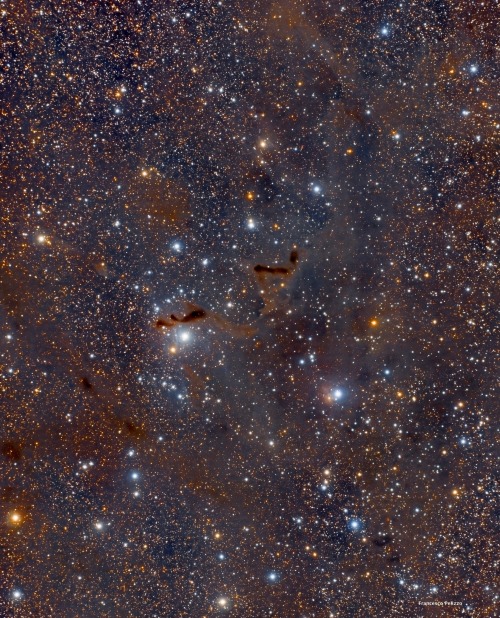
A Giving Hand, vdB9 // DocRx










Fontainebleau forest in France
All these are post-organic material: a petrified bones and organs of giants.
Dunkleosteus

Dunkleosteus, a placoderm, or armoured, fish. It lived around 370 million years ago, during the Devonian period and is arguably the biggest predator of its time. This was a truly impressive fish, literally hard as nails, its head was encased in a solid armour plating and like a shark, it had a streamlike body to swiftly move through the water. Its heavy armour means it would’ve been a relatively slow swimmer, yet capable of short spurts of speed, sort of like some sharks today.
This formidable beast had a major evolutionary strength, a moveable jaw. Fish began to dominate the oceans when they evolved the ability to move their jaw, yet Dunkleosteus had no teeth, what it had was much more menacing. It had razor like blades to slice its prey apart, like a pair of scissors to paper, with a bite more powerful than a great white. It would’ve been able to slice its prey in half so it was able to consume huge animals, yet on the downside the Dunkleosteus was unable to chew and on occasion its stomach found the huge chunks of meat hard to handle, evidence of this is in fossilised sick of the Dunkleosteus that has been found…

(Dunkleosteus armour means its head is often very well preserved. You can see how its teeth would’ve been more than capable of shearing through flesh.)
Relatives of the dunkleosteus, other armoured fish, were mostly dog sized, but Dunkleosteus was an exception. At 6 metres long on average, twice the length of human, this was a seriously big fish, yet it could reach up to 10 metres long, the length of a bus.

Dunkleosteus seems like the perfect predator. However, in its bony plates, indents of other animal teeth have been found suggesting that despite its strength, it was itself hunted. Dunkloesteus teeth marks have been found in its own fossils, they would eat whatever they could get their teeth into, including each other. The success of this gigantic beast was short lived, it was outcompeted by the more nimble sharks. Placoderm fish themselves would be extinct by the end of the devonian, taking the Dunkleosteus with it.
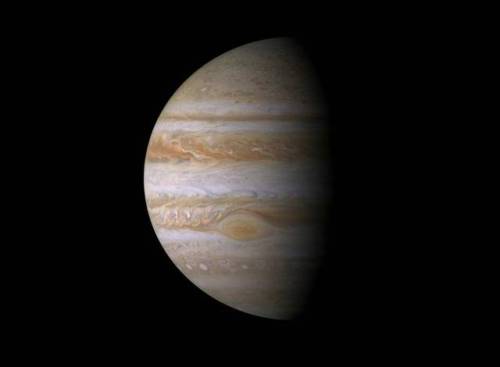
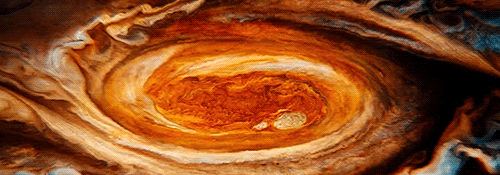
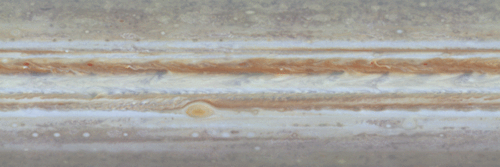
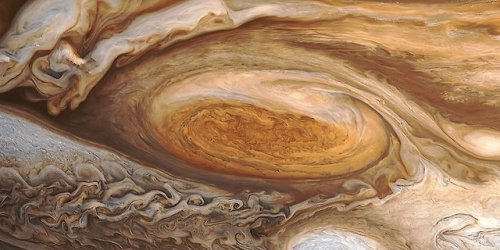
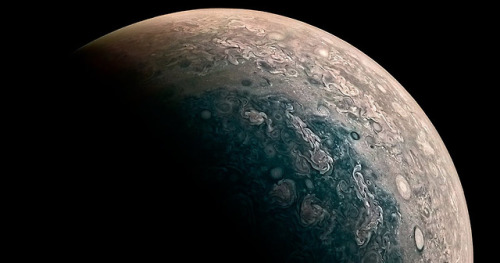
Jupiter is perpetually covered with clouds composed of ammonia crystals and possibly ammonium hydrosulfide. The clouds are located in the tropopause and are arranged into bands of different latitudes, known as tropical regions. These are sub-divided into lighter-hued zones and darker belts. The interactions of these conflicting circulation patterns cause storms and turbulence. Wind speeds of 100 m/s (360 km/h) are common in zonal jets. The zones have been observed to vary in width, color and intensity from year to year, but they have remained sufficiently stable for scientists to give them identifying designations.
The cloud layer is only about 50 km (31 mi) deep, and consists of at least two decks of clouds: a thick lower deck and a thin clearer region. There may also be a thin layer of water clouds underlying the ammonia layer. Supporting the idea of water clouds are the flashes of lightning detected in the atmosphere of Jupiter. These electrical discharges can be up to a thousand times as powerful as lightning on Earth. The water clouds are assumed to generate thunderstorms in the same way as terrestrial thunderstorms, driven by the heat rising from the interior.
source
-
 anynameisbetterthanmyfirstone liked this · 3 years ago
anynameisbetterthanmyfirstone liked this · 3 years ago -
 paulfe liked this · 3 years ago
paulfe liked this · 3 years ago -
 max-reblogs liked this · 3 years ago
max-reblogs liked this · 3 years ago -
 bramb reblogged this · 3 years ago
bramb reblogged this · 3 years ago -
 watterson-hobbes liked this · 4 years ago
watterson-hobbes liked this · 4 years ago -
 russianspacegeckosexparty liked this · 4 years ago
russianspacegeckosexparty liked this · 4 years ago -
 tigersbloodmantis liked this · 4 years ago
tigersbloodmantis liked this · 4 years ago -
 allaround87 liked this · 4 years ago
allaround87 liked this · 4 years ago -
 wayward-delver liked this · 4 years ago
wayward-delver liked this · 4 years ago -
 beaglerlove liked this · 4 years ago
beaglerlove liked this · 4 years ago -
 fortheusers17 liked this · 4 years ago
fortheusers17 liked this · 4 years ago -
 bowiecoded liked this · 4 years ago
bowiecoded liked this · 4 years ago -
 lbarbi liked this · 4 years ago
lbarbi liked this · 4 years ago -
 octoopyart liked this · 4 years ago
octoopyart liked this · 4 years ago -
 kyumiterasu reblogged this · 4 years ago
kyumiterasu reblogged this · 4 years ago -
 kyumiterasu liked this · 4 years ago
kyumiterasu liked this · 4 years ago -
 tawnyterror liked this · 4 years ago
tawnyterror liked this · 4 years ago -
 ravensfancy liked this · 4 years ago
ravensfancy liked this · 4 years ago -
 verdantnymph liked this · 4 years ago
verdantnymph liked this · 4 years ago -
 pangolin-404 liked this · 4 years ago
pangolin-404 liked this · 4 years ago -
 atlcocotli-xochitl liked this · 4 years ago
atlcocotli-xochitl liked this · 4 years ago -
 abbythegatekeeper liked this · 4 years ago
abbythegatekeeper liked this · 4 years ago -
 bookish120 liked this · 4 years ago
bookish120 liked this · 4 years ago -
 sab-me-now liked this · 4 years ago
sab-me-now liked this · 4 years ago -
 howltothemoon1802 liked this · 4 years ago
howltothemoon1802 liked this · 4 years ago -
 readingpeacebypiece reblogged this · 4 years ago
readingpeacebypiece reblogged this · 4 years ago -
 readingpeacebypiece liked this · 4 years ago
readingpeacebypiece liked this · 4 years ago -
 moonstruckmariner liked this · 4 years ago
moonstruckmariner liked this · 4 years ago -
 starry-system liked this · 4 years ago
starry-system liked this · 4 years ago -
 lemmejustyeet liked this · 4 years ago
lemmejustyeet liked this · 4 years ago -
 jamest-5 liked this · 4 years ago
jamest-5 liked this · 4 years ago -
 kamabokochan liked this · 4 years ago
kamabokochan liked this · 4 years ago -
 yaboijojo liked this · 4 years ago
yaboijojo liked this · 4 years ago -
 sirfowlman liked this · 4 years ago
sirfowlman liked this · 4 years ago -
 thepinksweatshirt reblogged this · 4 years ago
thepinksweatshirt reblogged this · 4 years ago -
 bigrockgang23 liked this · 4 years ago
bigrockgang23 liked this · 4 years ago -
 soupclub liked this · 4 years ago
soupclub liked this · 4 years ago -
 dihuang reblogged this · 4 years ago
dihuang reblogged this · 4 years ago -
 mrfiysh reblogged this · 4 years ago
mrfiysh reblogged this · 4 years ago -
 dangerous-wilds reblogged this · 4 years ago
dangerous-wilds reblogged this · 4 years ago -
 backroadsandbinders liked this · 4 years ago
backroadsandbinders liked this · 4 years ago

Amateur astronomer, owns a telescope. This is a side blog to satiate my science-y cravings! I haven't yet mustered the courage to put up my personal astro-stuff here. Main blog : @an-abyss-called-life
212 posts
